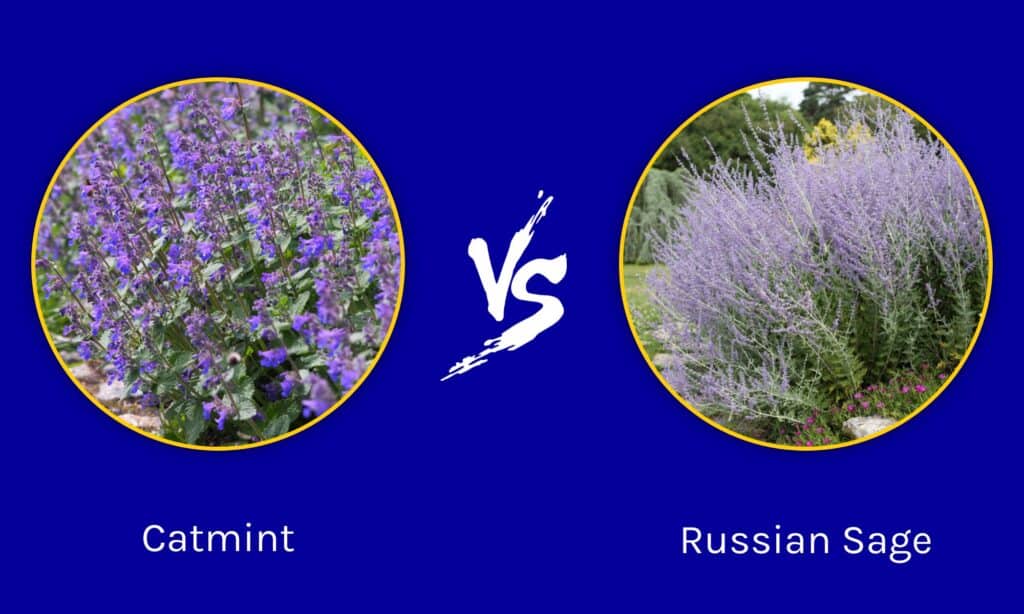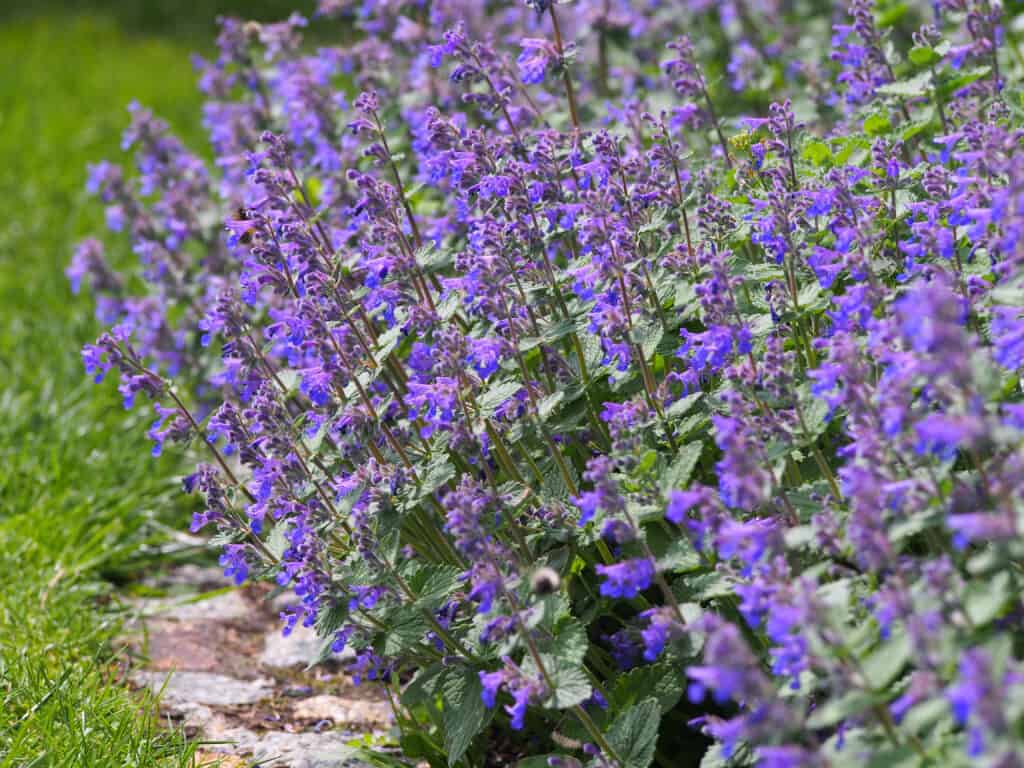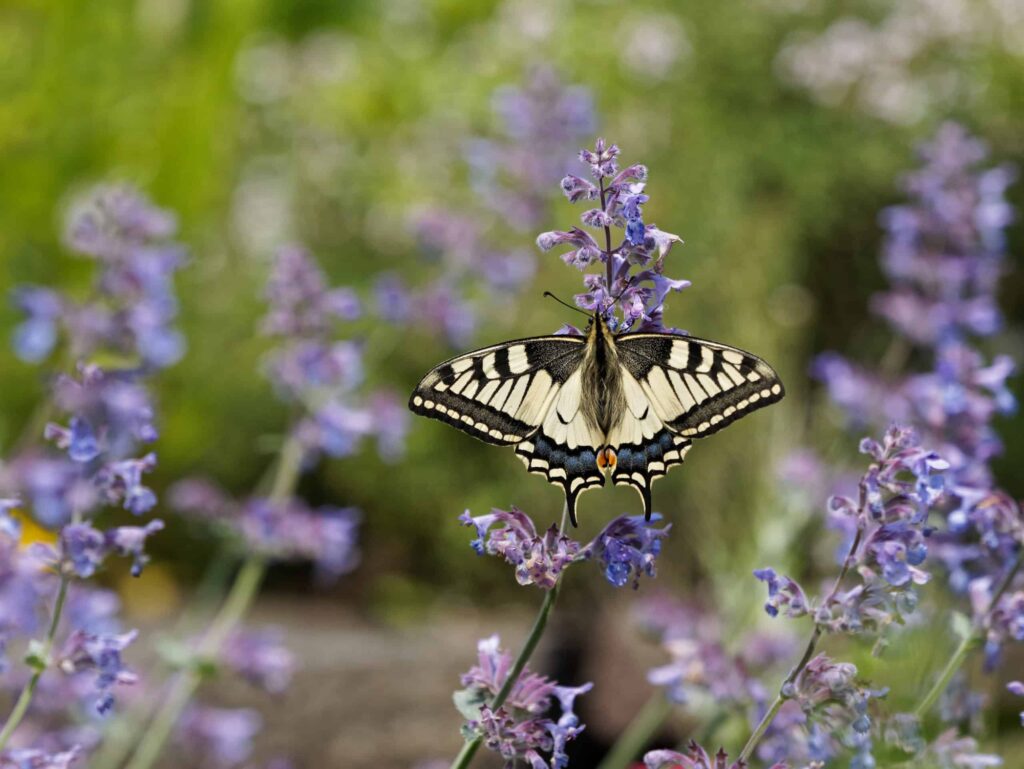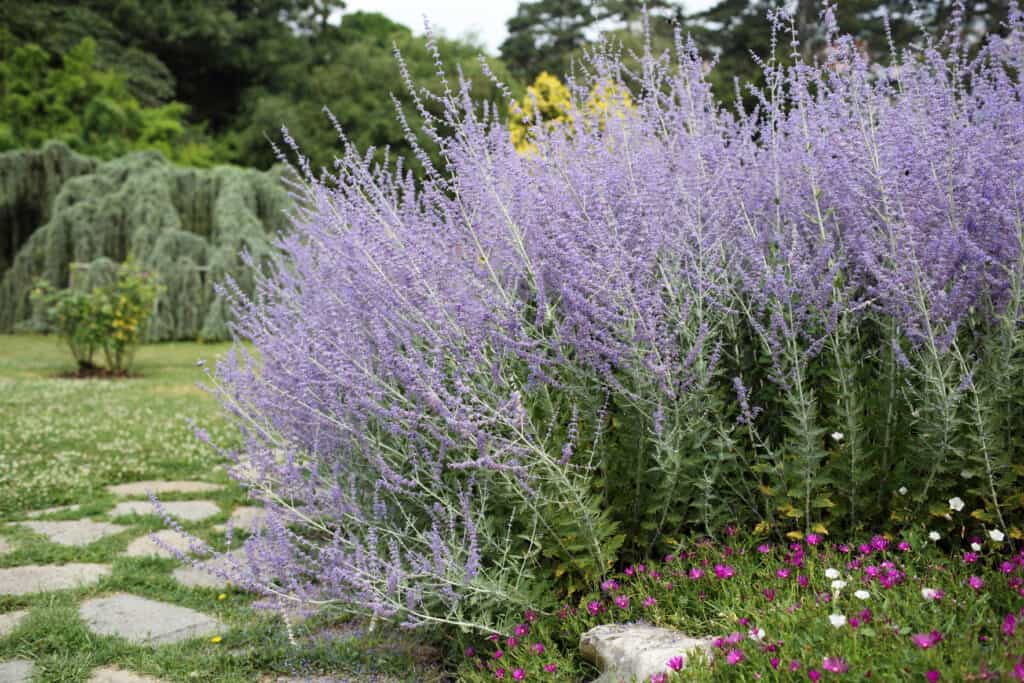Have you ever wondered why cats are attracted to certain herbs? Catmints are herbs that affect about 50 – 75% of our feline friends. Inhaling their fragrance may cause cats to exhibit euphoric behaviors like chin and cheek rubbing and head-shaking. The plants can also have hallucinogenic effects. This beautiful flowering perennial is not only alluring to cats but also to humans for its medicinal purpose and aesthetic value.
On the other hand, Russian sage is another perennial herb that produces bluish-purple flowers similar to some catmints. They attract many pollinators, such as bees and butterflies.
Russian sage and catmints may look similar, but they are separate species. Let’s compare the two and highlight their differences!
Comparing Catmint vs. Russian Sage

| Catmint | Russian Sage | |
|---|---|---|
| Classification | Kingdom: Plantae Clade: Tracheophytes Clade: Angiosperms Clade: Eudicots Clade: Asterids Order: Lamiales Family: Lamiaceae Genus: Nepeta | Kingdom: Plantae Clade: Tracheophytes Clade: Angiosperms Clade: Eudicots Clade: Asterids Order: Lamiales Family: Lamiaceae Genus: Salvia Subgenus: Salvia subg. Perovskia Species: Salvia yangii |
| Plant Type | Herbaceous perennial | Herbaceous perennial |
| Origin | Europe, Asia, Africa | Asia |
| Effect on Animals | Attracts pollinators like bees and butterflies, has euphoric effects on cats; repels mosquitoes and deer | Nontoxic to pets, Fragrant flowers are attractive to pollinators such as bees, butterflies, and hummingbirds |
| Human Uses | – Catmint essential oils are primarily used for medicinal purposes; – Has sedative effects on humans; – Catmint leaves are used for culinary purposes; | – Leaves are used to make herbal tea; – Ornamental plants for gardens |
| Hardiness Zone | Hardiness Zone 3 to 8 | Hardiness zone 5 to 9 |
The Key Differences Between Catmint vs. Russian Sage
Catmint and Russian sage plants look similar. They both have purple flowers that are a great addition to home gardens, but their classification, origin, and effects on animals and humans differ. Here are the four key differences between catmint vs. Russian sage.
Catmint vs. Russian Sage: Classification and Origin

Catmints originated from various regions in Europe and Asia that have mild temperatures.
©Anna Gratys/Shutterstock.com
Catmint and Russian sage belong to the same family but are from different genera. Catmint refers to the Nepeta genus, while Russian sage is a species from the Salvia genus.
Catmint is a collective term that applies to all the species of the Nepeta genus in the “mint” (Lamiaceae) family. Nepeta is a multiregional genus consisting of over 250 species. One of the most well-known species is Nepeta cataria. Catmints originated from various regions in Europe and Asia that have mild temperatures. They are also native herbs of Macaronesia and Eastern Tropical Africa.
Here are some catmint types:
- Catnip or catmint (Nepeta cataria)
- Camphor catmint (Nepeta camphorata)
- Siberian catmint (Nepeta sibirica)
- Japanese catmint or short-stalked catmint (Nepeta subsessilis)
- Yellow catmint (Nepeta govaniana)
- Greek catmint (Nepeta parnassica)
- Dwarf catmint (Nepeta racemosa)
Russian sage, also known as Salvia yangii, is a species of the Salvia genus of the Lamiaceae family. The term “salvia” is derived from the Latin words ‘salvare’ and ’salvere,’ which means to heal and to be healthy. It was formerly known as Perovskia atriplicifolia, but recent taxonomic developments recategorized Perovskia as a subgenus to Salvia, hence the new name. Although it is commonly called Russian sage, it is not from Russia. Salvia yangii originated from the hills and grasslands of Southern to Central Asia.
Catmint vs. Russian Sage: Effects on Animals

Catmints attract bees and butterflies, which facilitates pollination.
©pipapur/Shutterstock.com
Members of the Nepeta genus have nepetalactone contents, which causes reactions in cats. Nepetalactone is a substance similar to feline pheromones, which is why it has a euphoric effect on them. When cats inhale this substance, which passes through their olfactory system, they may display heightened behaviors like going goofy or crazy. They will also rub their cheeks, as well as lick, chew and sniff stuff.
Catmints also attract bees, which facilitates pollination. Aside from their positive effects on cats and pollinators, they repel mosquitoes and are deer-resistant.
The beautiful purple Russian sage is not toxic to pets. Its beautiful and fragrant flowers attract bees, butterflies, and hummingbirds. Russian sage also has insect-repelling properties. Its distinct smell keeps mosquitoes away.
Catmint vs. Russian Sage: Human Uses
Some species of catmint are used to produce essential oils that have medicinal properties. Catmint has been used in traditional medicine for digestive and skin problems. Catnip oil has antiseptic compounds, which can be used to treat respiratory diseases. Moreover, the plants are often used to make tea and are believed to help people with anxiety and insomnia.
Catmint is often used in salads or other dishes for additional flavor.
Russian sage is another herbal tea commonly used to treat stomach aches and indigestion. Its leaves are usually put into hot water for about 15 to 20 minutes before drinking. In traditional medicine, Russian sage is used to reduce fever. To do so, people soak a towel in Russian sage tea and put it on their foreheads. Russian sage is also well sought after for its pretty and unique purple flowers. Because of its mosquito-repelling scent, it has become a great addition to gardens.
Catmint vs. Russian Sage: Hardiness Zones

Russian sage is most likely to survive in Zones 5 to 9.
©iStock.com/loflo69
The Hardiness Zone Map is a standard map of 13 geographic zones containing relevant information indicating whether a plant will survive in a specific location. The map was last updated in 2012 and contains data based on the average annual minimum temperature from the last 30 years.
Although the map occasionally changes, plants already thriving in your yard will most likely survive. However, if you’re new to gardening and are trying to decide whether you can grow catmint or Russian sage, you may refer to the hardiness zone map. Catmint thrives in Zones 3 to 8, while Russian sage is most likely to survive in Zones 5 to 9.
Up Next:
- Is Sage A Perennial Or Annual?
- Catnip vs. Mint: What’s the Difference?
- Russian Sage vs. Lavender: How Are They Different?
The photo featured at the top of this post is © iStock.com/Sergey Spritnyuk
Sources
- Science Direct, Available here: https://doi.org/10.1016/j.jep.2020.113679
- The Plant List, Available here: http://www.theplantlist.org/browse/A/Lamiaceae/Nepeta/
- Chicago Botanic Garden, Available here: https://www.chicagobotanic.org/sites/default/files/pdf/plantevaluation/no46_perovskia.pdf
- University of Minnesota Extension, Available here: https://extension.umn.edu/yard-and-garden-news/catmints-and-catnip-which-purrfect-your-garden
Thank you for reading! Have some feedback for us? Contact the AZ Animals editorial team.






